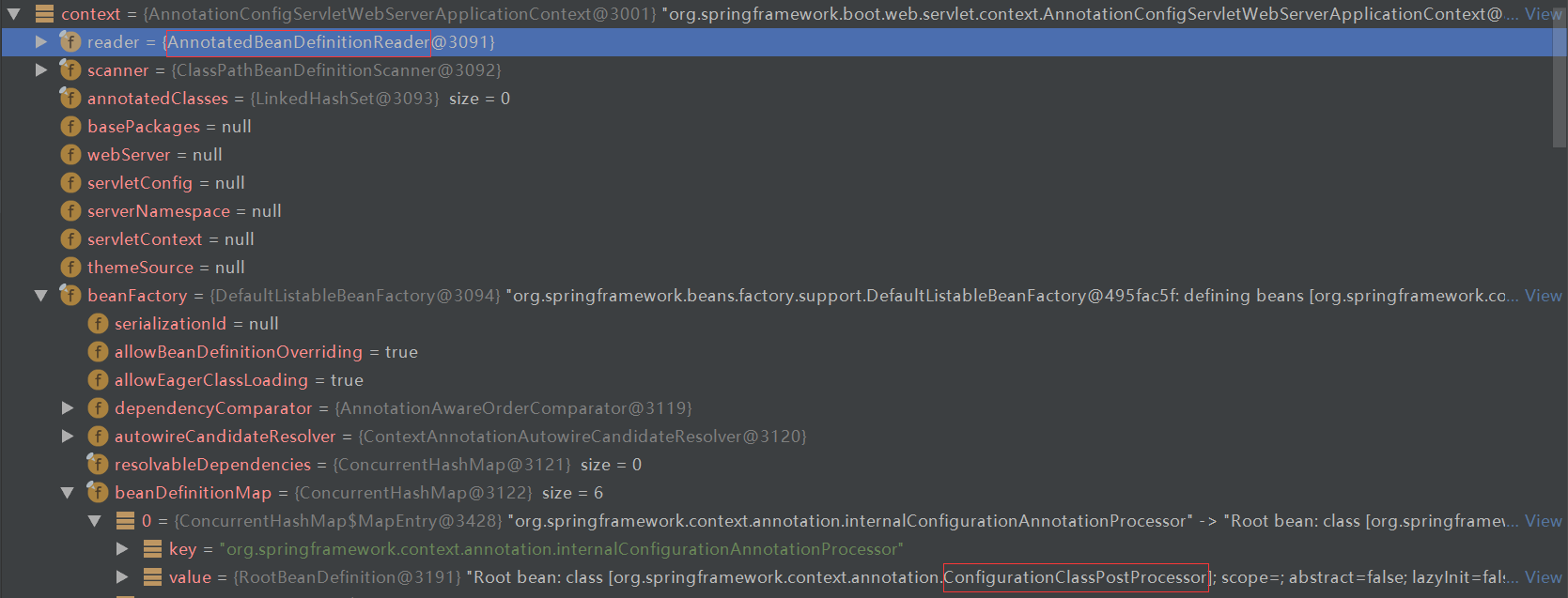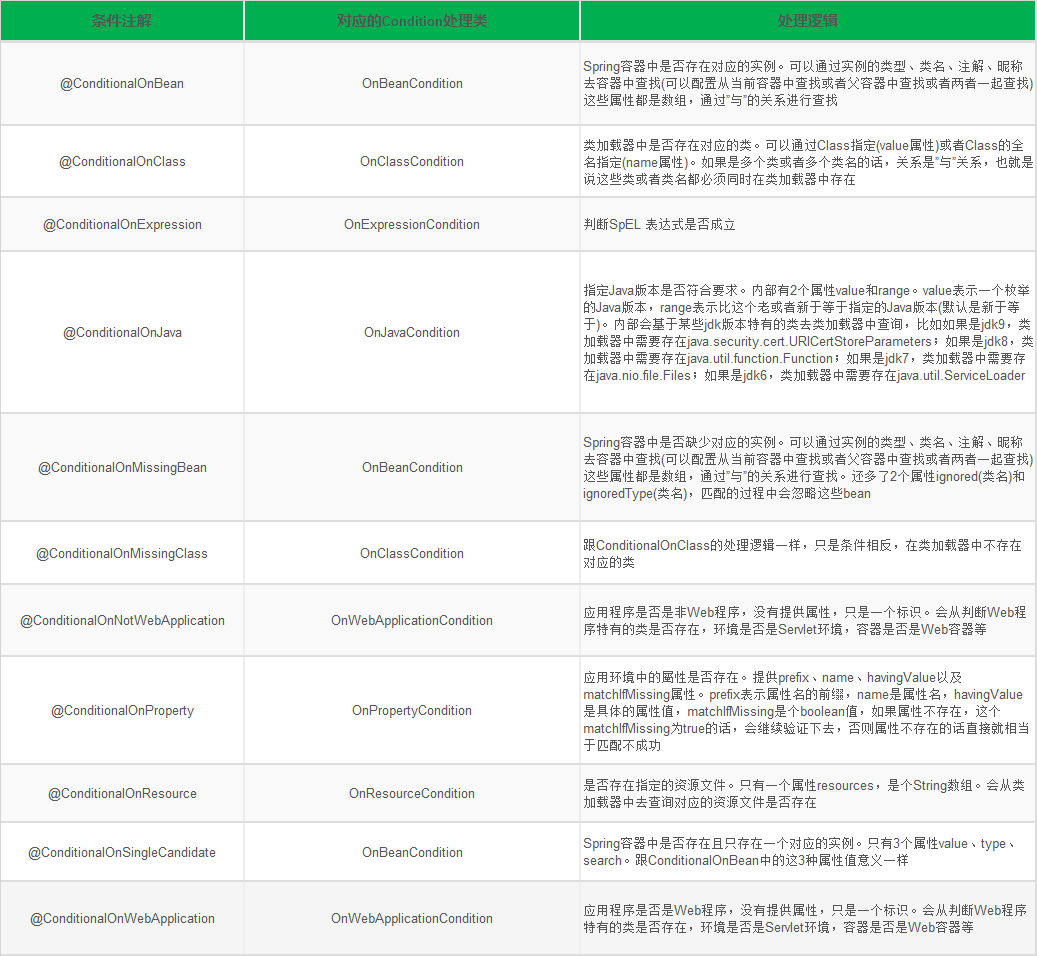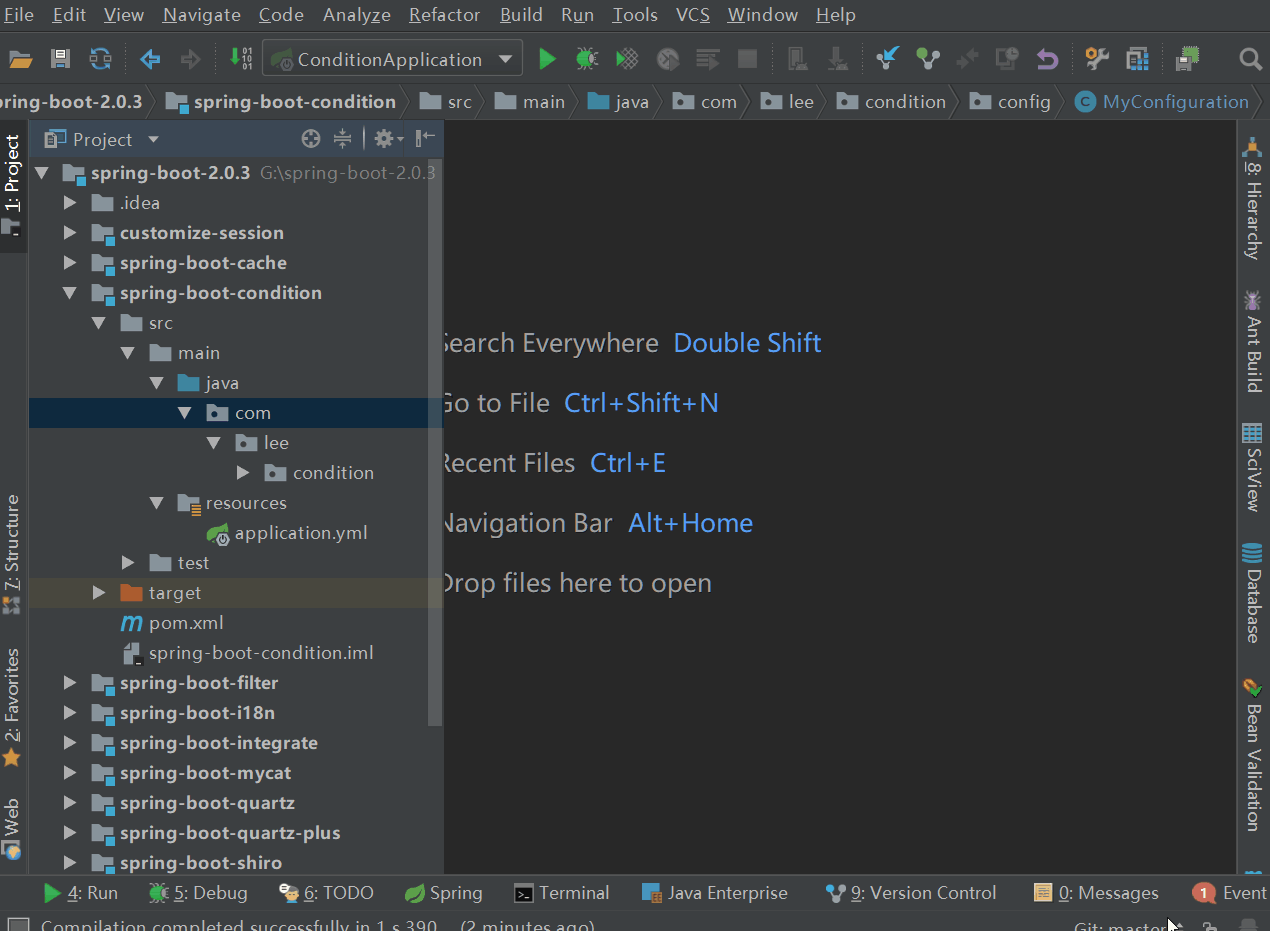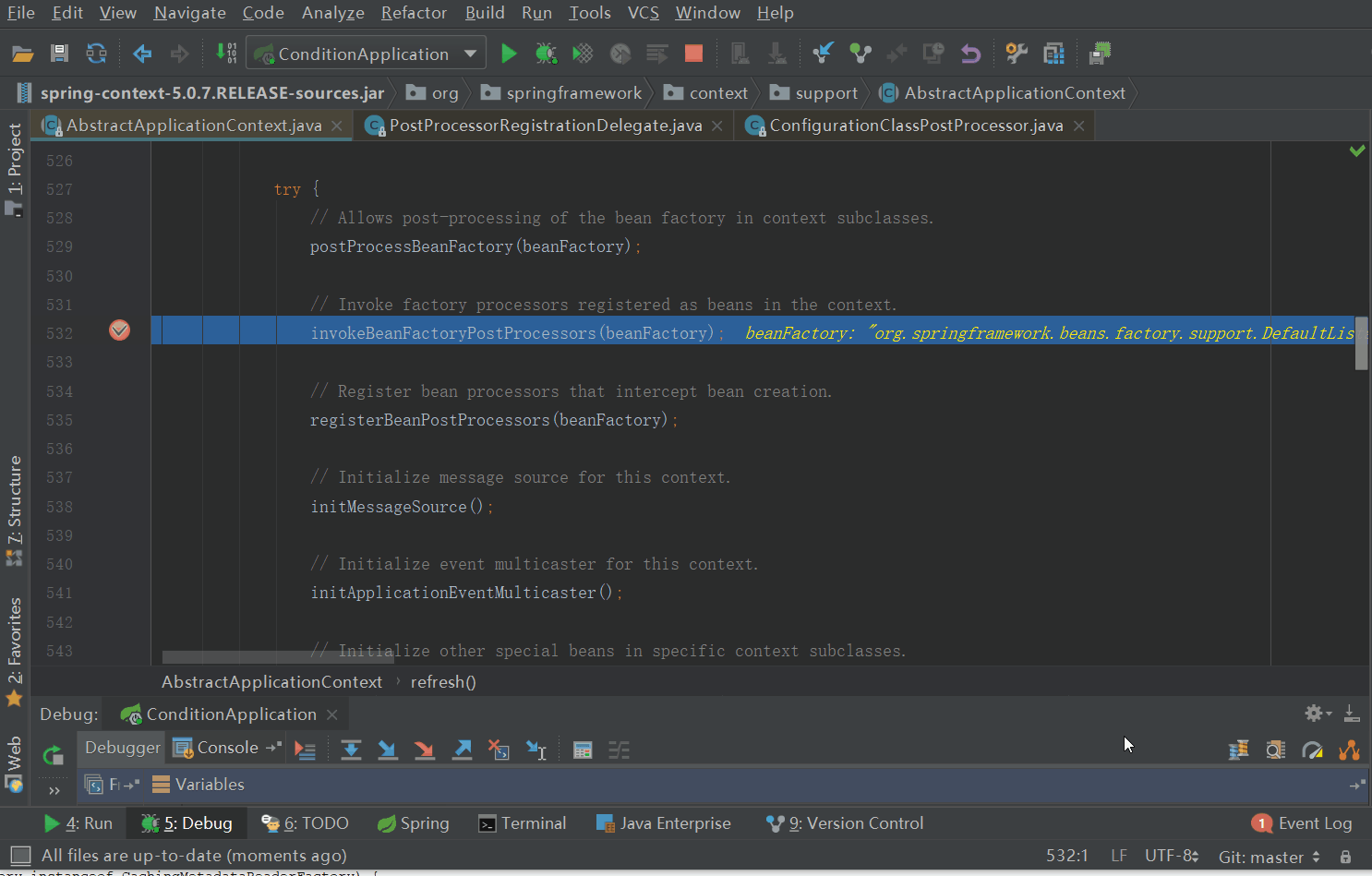spring-boot-2.0.3源码篇 - @Configuration、Condition与@Conditional
前言
开心一刻
一名劫匪慌忙中窜上了一辆车的后座,上车后发现主驾和副驾的一男一女疑惑地回头看着他,他立即拔出枪威胁到:“赶快开车,甩掉后面的警车,否则老子一枪崩了你!”,于是副驾上的男人转过脸对那女的说:“大姐,别慌,听我口令把刚才的动作再练习一遍,挂一档,轻松离合,轻踩油门,走...走,哎 走...哎,哎,对,走走... 最后,三人都躺到了医院,劫匪的手上还戴上了铐子...

路漫漫其修远兮,吾将上下而求索!
前情回顾
估摸着大家已经忘记了createApplicationContext的内容,本文不做过多的回顾,只是提醒大家:在AnnotationConfigServletWebServerApplicationContext的实例化过程中,实例化了AnnotatedBeanDefinitionReader,另外也将ConfigurationClassPostProcessor定义注册到了beanFactory中,如下图所示

看着AnnotatedBeanDefinitionReader、ConfigurationClassPostProcessor是不是隐约感觉到了什么? ConfigurationClassPostProcessor实现了BeanDefinitionRegistryPostProcessor,BeanDefinitionRegistryPostProcessor又实现了BeanFactoryPostProcessor,关于BeanFactoryPostProcessor,大家可以看看这篇文章:Spring拓展接口之BeanFactoryPostProcessor,占位符与敏感信息解密原理
概念介绍与应用
@Configuration
@Target(ElementType.TYPE)
@Retention(RetentionPolicy.RUNTIME)
@Documented
@Component
public @interface Configuration { /**
* Explicitly specify the name of the Spring bean definition associated
* with this Configuration class. If left unspecified (the common case),
* a bean name will be automatically generated.
* <p>The custom name applies only if the Configuration class is picked up via
* component scanning or supplied directly to a {@link AnnotationConfigApplicationContext}.
* If the Configuration class is registered as a traditional XML bean definition,
* the name/id of the bean element will take precedence.
* @return the suggested component name, if any (or empty String otherwise)
* @see org.springframework.beans.factory.support.DefaultBeanNameGenerator
*/
@AliasFor(annotation = Component.class)
String value() default ""; }
@Configuration能够修饰Class、interface和enum,用的最多的还是标注在类上,相当于把该类作为spring的xml配置文件中的<beans>,用于配置spring容器;@Configuration往往会结合@Bean来使用,@Bean等价于spring的xml配置文件中的<bean>,用于注册bean对象。@Configuration和@Bean组成了基于java类的配置,是spring的推荐配置方式。最简单的使用如下
@Configuration
public class MyConfiguration { @Bean
public Cat mycat() {
return new Cat();
}
}
如上代码就会在spring容器中注册一个名叫mycat的Cat类型的Bean
Condition
@FunctionalInterface
public interface Condition { /**
* Determine if the condition matches.
* @param context the condition context
* @param metadata metadata of the {@link org.springframework.core.type.AnnotationMetadata class}
* or {@link org.springframework.core.type.MethodMetadata method} being checked
* @return {@code true} if the condition matches and the component can be registered,
* or {@code false} to veto the annotated component's registration
*/
boolean matches(ConditionContext context, AnnotatedTypeMetadata metadata); }
Spring的条件化配置,当我们向spring注册bean时,可以对这个bean添加一定的自定义条件,当满足这个条件时注册这个bean,否则不注册。springboot中部分实现子类如下

springboot更多实现请查看org.springframework.boot.autoconfigure.condition包。Condition一般配合@Conditional使用,更多信息往下看
@Conditional
@Target({ElementType.TYPE, ElementType.METHOD})
@Retention(RetentionPolicy.RUNTIME)
@Documented
public @interface Conditional {
/**
* All {@link Condition}s that must {@linkplain Condition#matches match}
* in order for the component to be registered.
*/
Class<? extends Condition>[] value();
}
Spring的条件注解,其value是一个Class<? extends Condition>[],只有数组中的全部Condition全部匹配成功时,被@Conditional修饰的组件才会被注册到Spring容器中。@Conditional只是一个标志,标示需要进行条件判断,而具体的判断规则则由具体的Condition来实现。
在SpringBoot源码中很容易看到被@Conditional注解的组合注解,例如:@ConditionalOnBean、@ConditionalOnMissingBean、@ConditionalOnClass、@ConditionalOnMissingClass等,具体如下

springboot还提供了AutoConfigureAfter、AutoConfigureBefore、AutoConfigureOrder,看名字基本知道其作用,具体细节需要大家自己去跟了。
完整应用案例

接口都能访问通,数据返回也都正确,非常完美
完整工程代码:spring-boot-condition
当我们把MyConfiguration中的myCat方法注释掉(ConditionWeb中的cat相关也注释掉),再启动应用的时候,应用报错启动不起来,提示如下信息:
Description: Field dog in com.lee.condition.web.ConditionWeb required a bean of type 'com.lee.condition.model.Dog' that could not be found.
- Bean method 'myDog' in 'MyConfiguration' not loaded because @ConditionalOnBean (types: com.lee.condition.model.Cat; SearchStrategy: all) did not find any beans of type com.lee.condition.model.Cat Action: Consider revisiting the conditions above or defining a bean of type 'com.lee.condition.model.Dog' in your configuration.
ConditionWeb中需要Dog类型的bean,而Dog实例化又依赖Cat实例,而我们没有实例化Cat,所以应用启动报错,提示如上信息
源码探究
我们要探究什么了?不探究太细,就探究@Configuration修饰的配置类是何时解析的,@Conditional是何时生效、如何生效的
@Configuration修饰的配置类是何时解析的
ConfigurationClassPostProcessor是一个BeanFactoryPostProcessor(可以查看ConfigurationClassPostProcessor的类继承结构图),那么我们从AbstractApplicationContext的refresh方法调用的invokeBeanFactoryPostProcessors(beanFactory)方法开始

来到了processConfigurationClass方法,其详细代码如下
protected void processConfigurationClass(ConfigurationClass configClass) throws IOException {
// ConfigurationClass是否应该被skip
if (this.conditionEvaluator.shouldSkip(configClass.getMetadata(), ConfigurationPhase.PARSE_CONFIGURATION)) {
return;
}
ConfigurationClass existingClass = this.configurationClasses.get(configClass);
if (existingClass != null) {
if (configClass.isImported()) {
if (existingClass.isImported()) {
existingClass.mergeImportedBy(configClass);
}
// Otherwise ignore new imported config class; existing non-imported class overrides it.
return;
}
else {
// Explicit bean definition found, probably replacing an import.
// Let's remove the old one and go with the new one.
this.configurationClasses.remove(configClass);
this.knownSuperclasses.values().removeIf(configClass::equals);
}
}
// Recursively process the configuration class and its superclass hierarchy. 递归处理configuration class和它的父级类
// 也就说会递归处理我们的应用入口类:ConditionApplication.class,以及ConditionApplication.class的父级类
SourceClass sourceClass = asSourceClass(configClass);
do {
sourceClass = doProcessConfigurationClass(configClass, sourceClass);
}
while (sourceClass != null);
// 将满足条件的ConfigurationClass都放入configurationClasses集合中
// 后续会加载configurationClasses集合中所有的ConfigurationClass中配置的bean定义
this.configurationClasses.put(configClass, configClass);
}
其中shouldSkip方法如下
/**
* Determine if an item should be skipped based on {@code @Conditional} annotations.
* @param metadata the meta data
* @param phase the phase of the call
* @return if the item should be skipped
*/
public boolean shouldSkip(@Nullable AnnotatedTypeMetadata metadata, @Nullable ConfigurationPhase phase) {
// 如果这个类没有注解修饰,或者没有被@Conditional注解(包括Conditional系列)所修饰,不会skip
if (metadata == null || !metadata.isAnnotated(Conditional.class.getName())) {
return false;
} // 如果参数中沒有设置条件注解的生效阶段
if (phase == null) {
if (metadata instanceof AnnotationMetadata &&
ConfigurationClassUtils.isConfigurationCandidate((AnnotationMetadata) metadata)) {
return shouldSkip(metadata, ConfigurationPhase.PARSE_CONFIGURATION);
}
return shouldSkip(metadata, ConfigurationPhase.REGISTER_BEAN);
} // 要解析的配置类的条件集合,即@Conditional的value
List<Condition> conditions = new ArrayList<>();
for (String[] conditionClasses : getConditionClasses(metadata)) {
for (String conditionClass : conditionClasses) {
Condition condition = getCondition(conditionClass, this.context.getClassLoader());
conditions.add(condition);
}
} // 对条件进行排序
AnnotationAwareOrderComparator.sort(conditions); // 遍历条件,逐个匹配
for (Condition condition : conditions) {
ConfigurationPhase requiredPhase = null;
if (condition instanceof ConfigurationCondition) {
requiredPhase = ((ConfigurationCondition) condition).getConfigurationPhase();
}
// 条件注解的生效阶段满足,一旦有条件匹配不成功,则返回true,skip此类
if ((requiredPhase == null || requiredPhase == phase) && !condition.matches(this.context, metadata)) {
return true;
}
} return false;
}
我们再回过头去看processConfigBeanDefinitions方法
/**
* Build and validate a configuration model based on the registry of
* {@link Configuration} classes.
* 验证@Configuration修饰的类,满足条件则构建成configuration model
*/
public void processConfigBeanDefinitions(BeanDefinitionRegistry registry) {
List<BeanDefinitionHolder> configCandidates = new ArrayList<>();
String[] candidateNames = registry.getBeanDefinitionNames(); for (String beanName : candidateNames) {
BeanDefinition beanDef = registry.getBeanDefinition(beanName);
if (ConfigurationClassUtils.isFullConfigurationClass(beanDef) ||
ConfigurationClassUtils.isLiteConfigurationClass(beanDef)) {
if (logger.isDebugEnabled()) {
logger.debug("Bean definition has already been processed as a configuration class: " + beanDef);
}
}
else if (ConfigurationClassUtils.checkConfigurationClassCandidate(beanDef, this.metadataReaderFactory)) {
configCandidates.add(new BeanDefinitionHolder(beanDef, beanName));
}
} // Return immediately if no @Configuration classes were found
if (configCandidates.isEmpty()) {
return;
} // Sort by previously determined @Order value, if applicable
configCandidates.sort((bd1, bd2) -> {
int i1 = ConfigurationClassUtils.getOrder(bd1.getBeanDefinition());
int i2 = ConfigurationClassUtils.getOrder(bd2.getBeanDefinition());
return Integer.compare(i1, i2);
}); // Detect any custom bean name generation strategy supplied through the enclosing application context
// 检测自定义的bean生成策略
SingletonBeanRegistry sbr = null;
if (registry instanceof SingletonBeanRegistry) {
sbr = (SingletonBeanRegistry) registry;
if (!this.localBeanNameGeneratorSet) {
BeanNameGenerator generator = (BeanNameGenerator) sbr.getSingleton(CONFIGURATION_BEAN_NAME_GENERATOR);
if (generator != null) {
this.componentScanBeanNameGenerator = generator;
this.importBeanNameGenerator = generator;
}
}
} if (this.environment == null) {
this.environment = new StandardEnvironment();
} // Parse each @Configuration class
// 解析每一个被@Configuration修饰的class
ConfigurationClassParser parser = new ConfigurationClassParser(
this.metadataReaderFactory, this.problemReporter, this.environment,
this.resourceLoader, this.componentScanBeanNameGenerator, registry); Set<BeanDefinitionHolder> candidates = new LinkedHashSet<>(configCandidates);
Set<ConfigurationClass> alreadyParsed = new HashSet<>(configCandidates.size());
do {
parser.parse(candidates); // 解析过程中会将满足条件的@Configuration class存放到configurationClasses中
parser.validate(); // 满足条件的@Configuration class 都存放在了parser的configurationClasses中
Set<ConfigurationClass> configClasses = new LinkedHashSet<>(parser.getConfigurationClasses());
configClasses.removeAll(alreadyParsed); // Read the model and create bean definitions based on its content
// 读取@Configuration class中的配置(各个@Bean),并创建对应的bean definition(后续创建bean实例会用到bean定义)
if (this.reader == null) {
this.reader = new ConfigurationClassBeanDefinitionReader(
registry, this.sourceExtractor, this.resourceLoader, this.environment,
this.importBeanNameGenerator, parser.getImportRegistry());
}
this.reader.loadBeanDefinitions(configClasses); // 加载全部@Configuration class中的配置
alreadyParsed.addAll(configClasses); candidates.clear();
if (registry.getBeanDefinitionCount() > candidateNames.length) {
String[] newCandidateNames = registry.getBeanDefinitionNames();
Set<String> oldCandidateNames = new HashSet<>(Arrays.asList(candidateNames));
Set<String> alreadyParsedClasses = new HashSet<>();
for (ConfigurationClass configurationClass : alreadyParsed) {
alreadyParsedClasses.add(configurationClass.getMetadata().getClassName());
}
for (String candidateName : newCandidateNames) {
if (!oldCandidateNames.contains(candidateName)) {
BeanDefinition bd = registry.getBeanDefinition(candidateName);
if (ConfigurationClassUtils.checkConfigurationClassCandidate(bd, this.metadataReaderFactory) &&
!alreadyParsedClasses.contains(bd.getBeanClassName())) {
candidates.add(new BeanDefinitionHolder(bd, candidateName));
}
}
}
candidateNames = newCandidateNames;
}
}
while (!candidates.isEmpty()); // Register the ImportRegistry as a bean in order to support ImportAware @Configuration classes
if (sbr != null && !sbr.containsSingleton(IMPORT_REGISTRY_BEAN_NAME)) {
sbr.registerSingleton(IMPORT_REGISTRY_BEAN_NAME, parser.getImportRegistry());
} if (this.metadataReaderFactory instanceof CachingMetadataReaderFactory) {
// Clear cache in externally provided MetadataReaderFactory; this is a no-op
// for a shared cache since it'll be cleared by the ApplicationContext.
((CachingMetadataReaderFactory) this.metadataReaderFactory).clearCache();
}
}
@Conditional是何时生效、如何生效的
这个问题再上面已经全部得到体现,Spring不会无脑的加载所有的@Configuration class,只会加载满足条件的@Configuration class,而@Conditional就是条件标志,至于条件匹配规则这由Condition提供;shouldSkip方法中用到Conditional和Condition,完成条件的匹配处理。
总结
1、@Configuration和@Bean组成了基于java类的配置,与xml中的<Beans>、<Bean>功能一致,Spring推荐java类的配置;
2、Condition与@Conditional实现了条件配置,只有满足了条件的@Configuration class和@Bean才会被注册到Spring容器;
3、Spring以我们的应用启动类为基础来递归扫描配置类,包括我们应用中的配置类、Spring自己的以及第三方的配置类(springboot集成的各种配置类(spring-boot-autoconfigure-xxx.RELEASE.jar下的spring.factories文件中的Auto Configure),还有pageHelper的自动配置,等等);前提是需要开启自动配置(@EnableAutoConfiguration)。
参考
Spring 工具类 ConfigurationClassParser 分析得得到配置类
spring-boot-2.0.3源码篇 - @Configuration、Condition与@Conditional的更多相关文章
- Spring Boot 2.0系列文章(五):Spring Boot 2.0 项目源码结构预览
关注我 转载请务必注明原创地址为:http://www.54tianzhisheng.cn/2018/04/15/springboot2_code/ 项目结构 结构分析: Spring-boot-pr ...
- springboot2.0.3源码篇 - 自动配置的实现,发现也不是那么复杂
前言 开心一刻 女儿: “妈妈,你这么漂亮,当年怎么嫁给了爸爸呢?” 妈妈: “当年你爸不是穷嘛!‘ 女儿: “穷你还嫁给他!” 妈妈: “那时候刚刚毕业参加工作,领导对我说,他是我的扶贫对象,我年轻 ...
- Spring Boot 揭秘与实战 源码分析 - 工作原理剖析
文章目录 1. EnableAutoConfiguration 帮助我们做了什么 2. 配置参数类 – FreeMarkerProperties 3. 自动配置类 – FreeMarkerAutoCo ...
- Spring Boot 揭秘与实战 源码分析 - 开箱即用,内藏玄机
文章目录 1. 开箱即用,内藏玄机 2. 总结 3. 源代码 Spring Boot提供了很多”开箱即用“的依赖模块,那么,Spring Boot 如何巧妙的做到开箱即用,自动配置的呢? 开箱即用,内 ...
- Spring Boot 注解之ObjectProvider源码追踪
最近依旧在学习阅读Spring Boot的源代码,在此过程中涉及到很多在日常项目中比较少见的功能特性,对此深入研究一下,也挺有意思,这也是阅读源码的魅力之一.这里写成文章,分享给大家. 自动配置中的O ...
- spring-boot-2.0.3源码篇 - pageHelper分页,绝对有值得你看的地方
前言 开心一刻 说实话,作为一个宅男,每次被淘宝上的雄性店主追着喊亲,亲,亲,这感觉真是恶心透顶,好像被强吻一样.........更烦的是我每次为了省钱,还得用个女号,跟那些店主说:“哥哥包邮嘛么叽. ...
- spring-boot-2.0.3源码篇 - filter的注册,值得一看
前言 开心一刻 过年女婿来岳父家走亲戚,当时小舅子主就问:姐夫,你什么时候能给我姐幸福,让我姐好好享受生活的美好.你们这辈子不准备买一套大点的房子吗?姐夫说:现在没钱啊!不过我有一个美丽可爱的女儿,等 ...
- spring-boot-2.0.3源码篇 - 国际化
前言 针对spring boot,网上已有很多优质的系列教程,我就不再班门弄斧了(实际上是担心没别人写的好,哈哈哈!).但是还是想蹭蹭spring boot的热度,即使不考虑微服务,spring bo ...
- SpringBoot 源码解析 (八)----- Spring Boot 精髓:事务源码解析
本篇来讲一下SpringBoot是怎么自动开启事务的,我们先来回顾一下以前SSM中是如何使用事务的 SSM使用事务 导入JDBC依赖包 众所周知,凡是需要跟数据库打交道的,基本上都要添加jdbc的依赖 ...
随机推荐
- 【建图+最短路】Bzoj1001 狼抓兔子
Description 现在小朋友们最喜欢的"喜羊羊与灰太狼",话说灰太狼抓羊不到,但抓兔子还是比较在行的,而且现在的兔子还比较笨,它们只有两个窝,现在你做为狼王,面对下面这样一个 ...
- 【线段树】Bzoj1798 [AHOI2009] 维护序列
Description 老师交给小可可一个维护数列的任务,现在小可可希望你来帮他完成. 有长为N的数列,不妨设为a1,a2,…,aN .有如下三种操作形式: (1)把数列中的一段数全部乘一个值; (2 ...
- BZOJ_1260_[CQOI2007]涂色paint _区间DP
BZOJ_1260_[CQOI2007]涂色paint _区间DP 题意: 假设你有一条长度为5的木版,初始时没有涂过任何颜色.你希望把它的5个单位长度分别涂上红.绿.蓝.绿.红色,用一个长度为5的字 ...
- [SDOI2011]染色 BZOJ2243 树链剖分+线段树
分析: 区间合并,lcol是左端点的颜色编号,rcol是右端点的颜色编号,那么我们向上合并的时候,如果左儿子的rcol等于右儿子的lcol那么区间的sum--. 另外,如果重链顶的颜色等于重链顶的父节 ...
- python环境下实现OrangePi Zero寄存器访问及GPIO控制
最近入手OrangePi Zero一块,程序上需要使用板子上自带的LED灯,在网上一查,不得不说OPi的支持跟树莓派无法相比.自己摸索了一下,实现简单的GPIO控制方法,作者的Zero安装的是Armb ...
- 你真的知道final关键字吗?
概述 final在英文中是最终的,不可更改的.在Java中final修饰变量,函数和类,就像这个单词的意思,一旦使用赋值之后不可更改. final修饰的变量不可以被改变 finalTest类 publ ...
- Emmagee--APP性能测试工具的基本使用
一.Emmagee介绍 Emmagee是监控指定被测应用在使用过程中占用机器的CPU.内存.流量资源的性能测试小工具.该工具的优势在于如同windows系统性能监视器类似,它提供的是数据采集的功能,而 ...
- Java的多态浅谈
概述 Java的四大基本特性:抽象,封装,继承和多态.其中,抽象,封装,继承可以说多态的基础,而多态是封装,继承的具体表现.如果非要用专业术语来描述什么是多态的话 多态是指程序中定义的引用变量所指向具 ...
- 多线程学习系列二(使用System.Threading)
一.什么是System.Threading.Thread?如何使用System.Threading.Thread进行异步操作 System.Threading.Thread:操作系统实现线程并提供各种 ...
- java游戏开发杂谈 - java编程怎么学
java语言包含很多的知识点,我们并不需要把java语言的知识点都学全了,才开始编程. 你只需要了解: 1,java的数据类型和变量定义 2,类和对象的初步印象. 3,if-else, wh ...
